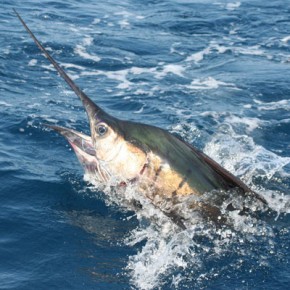Do some boats raise fish better than others? You bet they do, but why? And, how can a 25 foot Mexican panga raise more fish than a “no expenses spared” 45 foot sport fisher? It is all about the Holy Trinity of Resonance, Vibration and the Horsepower to Weight Ratio.
First you must understand how a blue water game fish finds his meals. He detects bait fish, which can be way beyond his visibility, by picking up the vibrations of the bait along the lateral line. This sensory organ, running along the mid-point for the length of is body tells him more about what is happening than his eyes ever will. Over the lifetime of the fish, it is imprinted as to the size of the bait and the size of the school from just the readings of his lateral line.
With a properly tuned boat running a trolling spread, the bill fish senses the correct resonance and vibrations, and goes over to investigate. The white water behind the propellers is creating white foam turbulence just like tuna in a feeding frenzy, and a couple of the desired sized baits are also coming in to investigate: No matter what the brain registers, the predatory feeding instinct takes over, and the fish has to strike at the baits.
And, there you are. There is the answer 100%. Now, if you do like the boat manufactures (and lure manufactures too) and try to match those vibrations, you will have a fish raising machine. Unfortunately, with millions of dollars of research invested, the magical formula has yet to be found.
A friend of mine did not spend quite that much money trying to find the right formula, but he did lose two seasons of fishing. Karl had a 24 foot boat with a nice wide beam and a single six-cylinder diesel engine. The numbers of blue marlin he raised was incredible. Twelve released blues in twelve days on the water was not unusual, and it was only him and his Mexican Captain, Cuate. Plus, the 200 pound plus yellow-fin tuna were eating the trolled lures in the spread too. And, I am not even counting the eight to twelve raised sailfish a day he finally got tired of catching; even after switching to a fly rod.
He was working the areas out to 40 to 45 miles offshore and decided what he needed was a bigger boat (29 foot) with twin engines, a wider beam, tower, and enough room for a deckhand. Unfortunately, as far as fishing, he had just shot himself in the foot. We are talking the expense of buying another boat from a very highly esteemed manufacture, towing his 24 foot boat back to the States and taking a substantial beating on the sale, and bringing the other boat, via the Panama Canal, by barge from the East Coast of the United States to the West Coast of Mexico.
With his new boat, he could only raise a couple of fish a day, usually sailfish. The blue marlins were few and far between. Since it was a practically new boat, and no unwarranted vibrations were coming off the drive shaft, transmission, rudders, or engines, the obvious culprits were the propellers, and the RPMs of the engine verses speed. Will it give off better resonance with a three blade prop or a four? What pitch and how much cup for a matched pair, or what diameter? The boat had the recommended manufacture’s propellers for the East Coast so he was in uncharted waters for the West Coast of Mexico fishing. Different vibrations (and different bait fish) were the problems.
He did finally get it solved, but transporting two large propellers back and forth from Mexico to the United States and testing the propellers for at least a couple of weeks, only to do it all over again, was no small endeavor.
How is it that a simple panga with a 75 hp outboard works so well from day one? It is a proven formula, repeated thousands of times every day in Mexico. The Holy Trinity of Resonance, Vibration and Horse Power to Weight Ratio are all there. More bill fish are caught by pangas, than any other style of boat in the world.
- The Super Panga, Huntress, in Zihuatanejo Bay. Photo by Ed Kunze.
- Sailfish breaking the surface. Photo by Ed Kunze.






